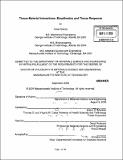| dc.contributor.advisor | Elazer R. Edelman. | en_US |
| dc.contributor.author | Shazly, Tarek (Tarek Michael) | en_US |
| dc.contributor.other | Massachusetts Institute of Technology. Dept. of Materials Science and Engineering. | en_US |
| dc.date.accessioned | 2010-04-28T17:04:09Z | |
| dc.date.available | 2010-04-28T17:04:09Z | |
| dc.date.copyright | 2009 | en_US |
| dc.date.issued | 2009 | en_US |
| dc.identifier.uri | http://hdl.handle.net/1721.1/54577 | |
| dc.description | Thesis (Ph. D.)--Massachusetts Institute of Technology, Dept. of Materials Science and Engineering, 2009. | en_US |
| dc.description | Cataloged from PDF version of thesis. | en_US |
| dc.description | Includes bibliographical references (p. 159-162). | en_US |
| dc.description.abstract | Diverse interactions between soft tissues and implanted biomaterials directly influence the success or failure of therapeutic interventions. The nature and extent of these interactions strongly depend on both the tissue and material in question and can presumably be characterized for any given clinical application. Nevertheless, optimizing biomaterial performance remains a challenge in many implant scenarios due to complex relationships between intrinsic material properties and tissue response. Soft tissue sealants are clinically-relevant biomaterials which impart therapeutic benefit through adhesion to tissue, thus exhibiting a direct functional dependence on tissue-material reactivity. Because adhesion can be rigorously quantified and correlated to the local tissue response, sealants provide an informative platform for studying material properties, soft tissues, and their interplay. We developed a model hydrogel sealant composed of aminated polyethylene glycol and dextran aldehyde (PEG:dextran) that can possess a wide range of bulk and adhesive properties by virtue of constituent polymer modifications. Through comparison to traditional sealants, we established that highly viscoelastic adhesion promotes tissue-sealant interfacial failure resistance without compromising underlying tissue morphology. | en_US |
| dc.description.abstract | (cont.) We analyzed multiple soft tissues to substantiate the notion that natural biochemical variability facilitates the design of tissue-specific sealants which have distinct advantages over more general alternatives. We confirmed that hydrogel-based materials are an attractive material class for ensuring sealant biocompatibility, but found that a marked reduction in adhesive strength following characteristic swell can potentially limit clinical efficacy. To mitigate the swell-induced loss of hydrogel-based sealant functionality, a biomimetic conjugation strategy derived from marine mussel adhesion was applied to PEG:dextran and shown to favorably modulate adhesion. In all phases of this research, we defined material design principles that extend beyond the immediate development of PEG:dextran with potential to enhance the clinical performance of a range of biomaterials. | en_US |
| dc.description.statementofresponsibility | by Tarek Shazly. | en_US |
| dc.format.extent | 189 p. | en_US |
| dc.language.iso | eng | en_US |
| dc.publisher | Massachusetts Institute of Technology | en_US |
| dc.rights | M.I.T. theses are protected by
copyright. They may be viewed from this source for any purpose, but
reproduction or distribution in any format is prohibited without written
permission. See provided URL for inquiries about permission. | en_US |
| dc.rights.uri | http://dspace.mit.edu/handle/1721.1/7582 | en_US |
| dc.subject | Materials Science and Engineering. | en_US |
| dc.title | Tissue-material interactions : bioadhesion and tissue response | en_US |
| dc.type | Thesis | en_US |
| dc.description.degree | Ph.D. | en_US |
| dc.contributor.department | Massachusetts Institute of Technology. Department of Materials Science and Engineering | |
| dc.identifier.oclc | 568045938 | en_US |
